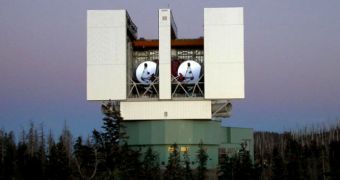Astronomers operating the new Large Binocular Telescope Interferometer (LBTI) are pleased to announce that the observatory has conducted its first astronomical observations, targeting the star Beta Peg in the constellation Pictor as its first observations target.
After some 8 years of development, the tool is now ready to begin surveying our cosmic neighborhood, in search for Earth-like exoplanets around nearby stars. The primary goal is finding an extrasolar planet that could support life as we know it.
Developed with funds from the American space agency, the observatory uses optical interferometry to combine data captured by two 8.4-meter (28-foot) mirrors mounted on Mount Graham, Arizona.
As a process, interferometry is simple to understand. Light captured by each of the mirrors is combined via complex computer software, which allows the twin telescopes to behave as if they were a single one.
This is important because the overall diameter of the “virtual” observatory thus obtained is as large as the distance between the two mirrors in the physical world.
So, for example, if we were to place two observatories some 100 miles away from each other, the diameter of the interferometer would be 100 miles. Constructing an actual telescope with a 100-mile mirror is technically and economically impossible and impractical.
“By combining the light of the telescopes, we’re able to realize its full potential. Together, the two mirrors form the largest single-mount telescope in the world,” says scientist Tom McMahon.
The expert holds an appointment at the University of Arizona in Tucson (UAT), and is also the manager of the LBTI project, Space Fellowship reports.
“The quality of the first-light images is wonderful. The telescope was stable and the instrument was working properly,” adds UAT expert Phil Hinz, the project's principal investigator.
The astronomers say that, with all its capabilities, the new telescope still won't be able to see Earth-sized exoplanets directly. It will therefore direct its observations power towards discovering protoplanetary disks, which are indicative of planetary formation.
“This instrument will help complete our picture of what planetary systems look like and be a pathfinder for finding Earth-like planets that are close by,” Hinz explains.
In 2011, a major upgrade is scheduled to be installed on the new telescope. A testing and commissioning phase will then follow, which will spread over the majority of the years. Scientific observations will begin soon after.
“This is the highest-resolution instrument of its kind in the world. We won’t just be able to image exoplanets, but extragalactic objects, nebulae and galaxies. It’s taken time to make sure it works as envisioned, but now it’s time to do science,” McMahon concludes.

 14 DAY TRIAL //
14 DAY TRIAL //